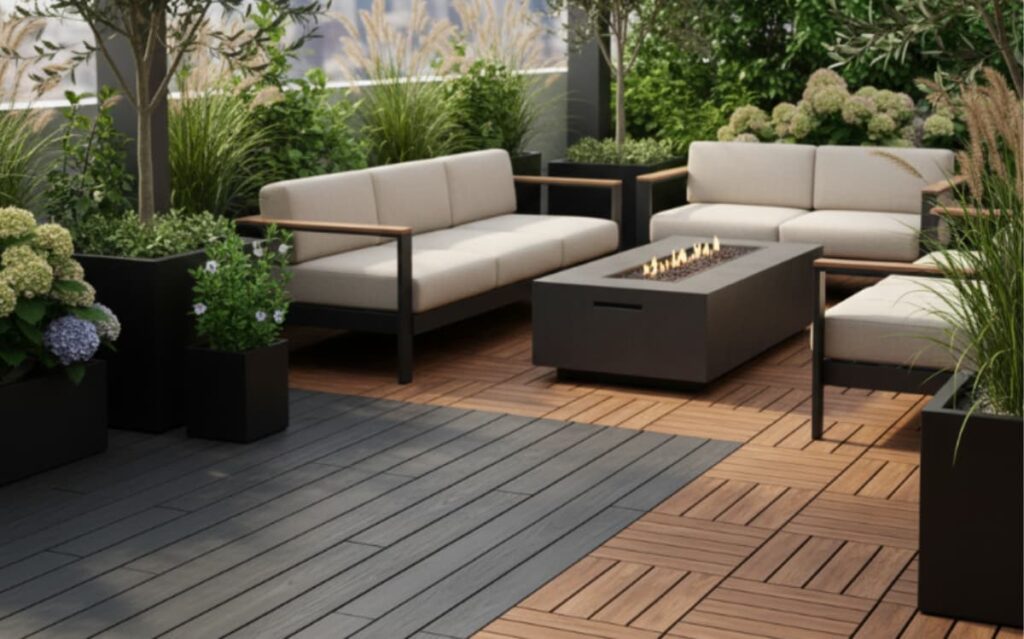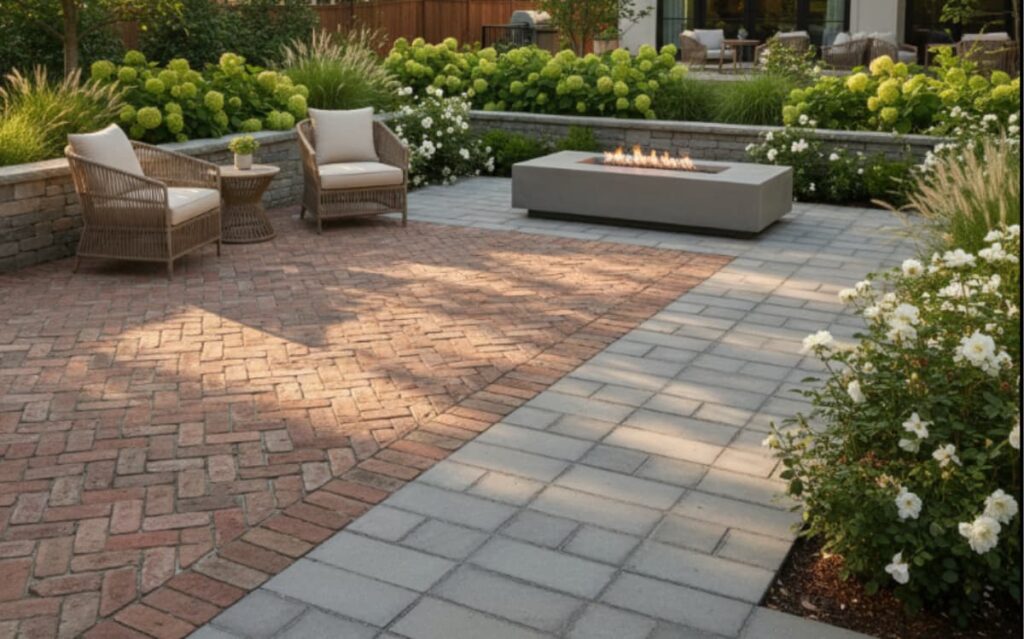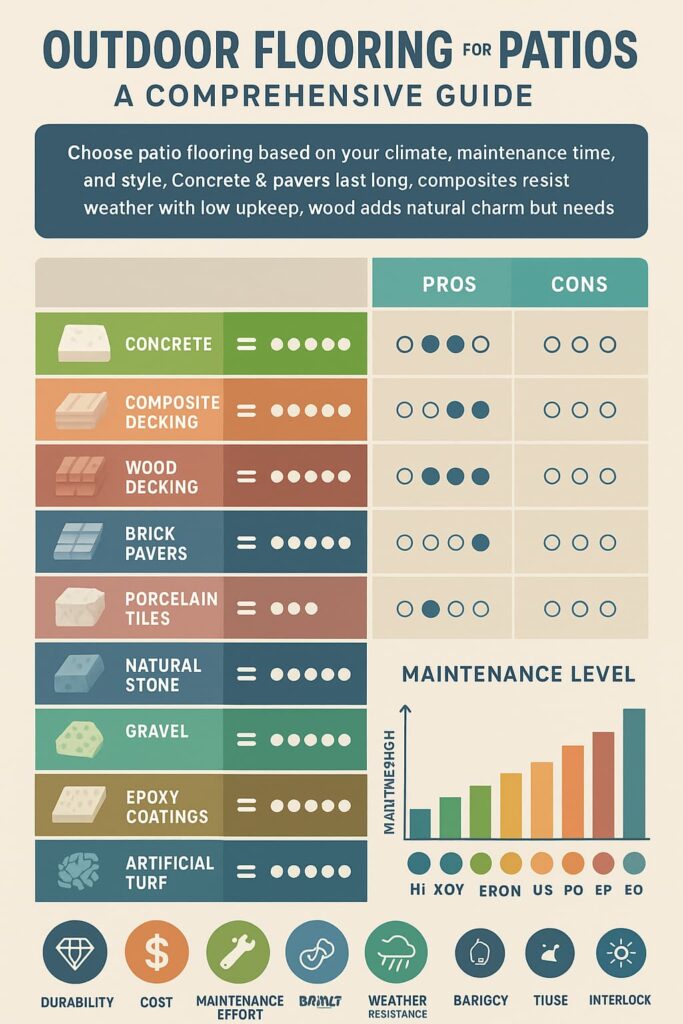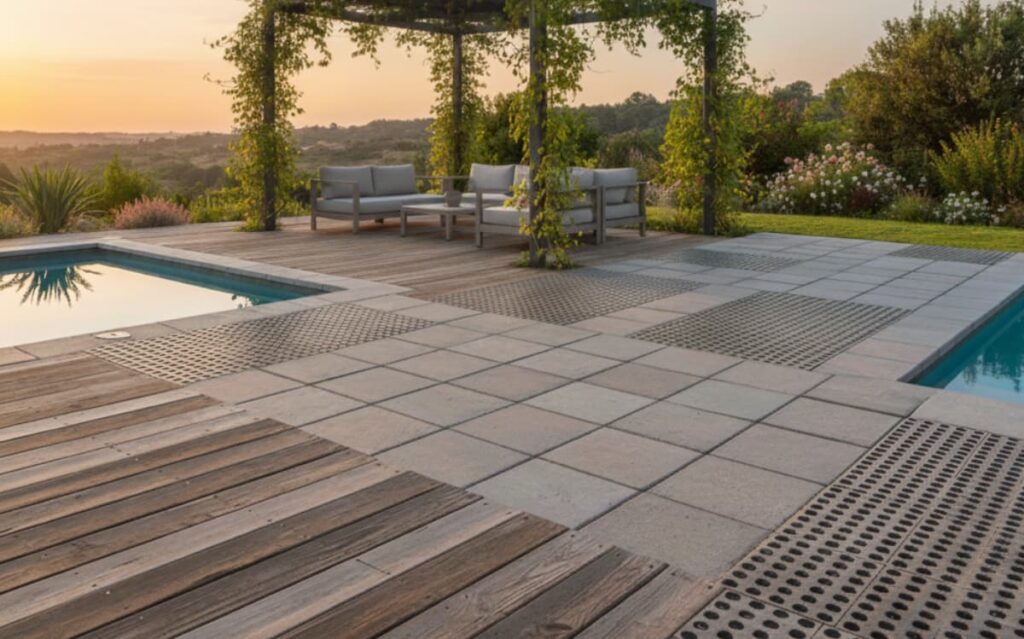Explore practical outdoor flooring options that balance durability, style, and maintenance for your patio space.
Outdoor flooring can make or break a patio. There’s no way around it, some materials look great but fall apart in harsh weather, while others might be tough as nails but don’t quite catch the eye.
We’ve watched countless homeowners struggle with this choice, and honestly, it’s not that complicated once you break it down. From traditional brick pavers that have stood the test of time to modern composites that barely need a second thought, there’s something that’ll work for your space and budget.
The right pick depends on what matters most to you, maybe it’s keeping maintenance low, or perhaps you’re after that perfect aesthetic. Keep reading, we’ll walk through what actually works (and what doesn’t) for real outdoor living spaces.
Key Takeaways
- For patio installation, pick your flooring based on where you live and how much time you’re willing to spend taking care of it
- Natural stone and concrete might cost more upfront, but they’ll probably outlast most other options
- If you don’t want to spend weekends maintaining your patio, go for composites or treated surfaces
Concrete Flooring

What is Concrete Flooring?
Walk around any neighborhood and you’ll spot concrete patios everywhere. There’s a reason for that, it’s basically cement that’s poured right where you need it, and these days, contractors can do some pretty incredible things with it. We’ve seen plain gray slabs transformed into what looks exactly like expensive stone (seriously, you’d have to get down on your hands and knees to tell the difference).
The stuff’s like a blank canvas. Add some color, stamp in a pattern, and suddenly that basic gray slab looks like it belongs in a fancy magazine. Some of our clients go for deep charcoal stains, while others want their concrete stamped to look just like those $15-per-square-foot pavers they fell in love with.
Pros and Cons of Concrete Flooring
Look, concrete’s tough, that’s just a fact. It’ll probably outlast your mortgage, and square foot for square foot, it won’t drain your savings like some other materials might. Plus, you can make it look like almost anything these days.
But it’s not perfect (nothing is, right?). Give it a few years, and you’ll probably see some cracks show up, especially if you live somewhere with harsh winters. And don’t even think about walking barefoot on it during July, that surface gets hot enough to fry an egg. You’ll need to seal it every couple years too, or it’ll start looking tired and stained.
Best Use Cases for Concrete Flooring
We’ve put in hundreds of concrete patios, and they really shine in bigger spaces where other materials would cost a fortune. It’s perfect for people who want something that looks modern and clean, without the hassle of individual pavers or tiles. Most of our clients who choose concrete are looking for that sweet spot, they want something that looks good and lasts long, but doesn’t require a second mortgage to install.
Composite Decking and Tiles
What is Composite Decking/Tiles?
Think wood, but better. That’s what composite decking is, it’s this clever mix of recycled wood bits and plastic that’s been taking over patios lately. We’ve watched it become huge in the last few years, especially those snap-together tiles that practically anyone can install (though we’d still recommend getting someone who knows what they’re doing).
Most folks can’t even tell it’s not real wood until they get up close. The best part? You won’t find yourself out there every spring with a bucket of stain and a brush. We’ve put this stuff in everywhere from snowy Michigan to rainy Seattle, and it just keeps looking good.
Pros and Cons of Composite Decking/Tiles
Here’s what’s great, you can forget about it once it’s installed. No rot, no fading (well, maybe a tiny bit after a few years), and bugs won’t touch it. You’ll spend your weekends actually enjoying your patio instead of maintaining it. Just spray it down with a hose when it gets dirty, and you’re good to go.
But let’s be real, it’s not cheap. You might need to sit down when you see the price tag compared to basic concrete. And on those 90-degree summer days? Yeah, you might want to wear shoes. We’ve measured surface temperatures up to 120 degrees in direct sun.
Best Use Cases for Composite Decking/Tiles
We love putting this stuff in places where the weather’s rough. Rain, snow, brutal sun, composite just shrugs it off. It’s perfect for busy families who don’t have time for maintenance, or really anyone who’d rather be grilling than sealing their deck. Plus, each board contains about 1,000 recycled plastic bags, so there’s that feel-good factor too.
Wood Decking

What is Wood Decking?
There’s something about real wood that just works. We’ve been installing decks for 15 years at Lapis Patios, and wood still gets the most “wow” reactions from our clients. Cedar’s probably our most-requested wood, it’s got this rich color that just gets better with age.
Put it under a pergola or extend it from a covered porch, and you’ve got something that looks like it grew right out of the house. We’ve watched kids grow up on these decks, seen countless barbecues, and honestly, nothing else quite matches that natural feel you get from real wood.
Pros and Cons of Wood Decking
Let’s be straight, wood’s gorgeous but it’s not a set-it-and-forget-it deal. Some of our clients love spending a weekend every year giving their deck some TLC. Others… well, they probably should’ve gone with composite.
- Pros: Feels amazing underfoot, looks better as it ages (if you take care of it), costs less than composite upfront, and you can always sand it down and start fresh
- Cons: You’ll need to seal it every year or two, termites think it’s an all-you-can-eat buffet if you’re not careful, and it can twist up like a pretzel if it gets too wet
Best Use Cases for Wood Decking
We’ve built hundreds of wood decks at Lapis Patios, and they really shine in the right spots. Covered areas are perfect, you get all the beauty without as much weather beating it up. Every summer we get calls from clients telling us how their wood deck’s become the family’s favorite hangout spot.
If you’re willing to put in maybe a weekend of work each year, and you want something that feels as natural as your garden, wood’s probably your best bet.
Brick and Concrete Pavers
What are Brick and Concrete Pavers?
Brick and concrete pavers are like building blocks for creativity. Laid piece by piece, they can form simple patterns or intricate designs that turn a plain patio into something with real character. One thing we love about pavers is the flexibility. You can mix sizes, shapes, and colors to create a surface that feels custom to your home. In our projects, we’ve seen how even a simple herringbone or running bond pattern can completely change the feel of an outdoor space.
Pros and Cons of Brick and Concrete Pavers
They’re practical too. Unlike a poured slab, you don’t lose everything if a section gets damaged, you just swap the individual piece. On the flip side, pavers aren’t maintenance-free, and you’ll need to occasionally keep weeds or shifting in check.
- Pros: Flexible design options, easy to repair, durable, blends with many home styles.
- Cons: Can shift if not installed on a solid base, joints may need resealing, requires occasional upkeep.
Best Use Cases for Brick and Concrete Pavers
Pavers work best in spaces where drainage matters, since water can pass through the small gaps. We’ve installed them for families who wanted a patio that felt both polished and personal, and the results are always rewarding. At Lapis Patios, we’ve seen homeowners enjoy the fact that their paver patio is never “cookie-cutter.” For someone who values both function and design freedom, pavers are a strong choice.
Porcelain and Ceramic Tile

What are Porcelain and Ceramic Tiles?
Porcelain and ceramic tiles bring a sense of refinement to patios that few other materials can match. Their smooth, clean finishes make outdoor spaces feel almost like indoor rooms.
Porcelain, in particular, has proven itself in our projects for its durability and resistance to water, making it perfect near pools or in humid areas. We’ve had clients choose tiles that mimic natural stone or even wood grain, giving them the best of both worlds: the beauty of natural textures and the practicality of tile.
Pros and Cons of Porcelain and Ceramic Tile
While tile is attractive and functional, it comes with its quirks. We always remind homeowners that tile can be slippery when wet, and while it resists water, it’s not invincible against impacts. Drop a heavy planter, and you might see a crack.
- Pros: Wide variety of styles, highly water-resistant, sleek finish, durable in the right conditions.
- Cons: Slippery when wet, can crack under heavy impact, requires a stable base to prevent shifting.
Best Use Cases for Porcelain and Ceramic Tile
Tiles thrive in spaces where moisture is unavoidable. Around pool decks, for instance, they hold up beautifully. At Lapis Patios, we’ve installed tile patios that instantly elevated backyards into stylish, resort-like spaces. If you’re aiming for a clean, contemporary design with low water concerns, tile is an excellent fit. It may not suit everyone, but when matched with the right setting, it transforms an outdoor area into something both practical and polished.
Natural Stone Flooring
What is Natural Stone Flooring?
Natural stone flooring brings a timeless charm that no manufactured surface can truly mimic. Each piece of flagstone, slate, or travertine tells its own story through its colors, veins, and textures.
Over the years, we’ve seen how these stones age beautifully, gaining a patina that actually enhances their character instead of diminishing it. When installed properly, natural stone doesn’t just serve as a surface, it becomes the foundation for a space that feels grounded and lasting.
Pros and Cons of Natural Stone Flooring
We’ve worked with homeowners who wanted their patio to feel like a true extension of the earth around it, and stone is unmatched for that. But there’s no denying that this elegance comes with some trade-offs.
- Pros: Exceptional durability, natural beauty, increases property value, unique appearance with no two stones alike.
- Cons: Higher cost compared to other options, heavier material that requires a professional touch, can be cold under bare feet.
Best Use Cases for Natural Stone Flooring
Stone is best suited for formal gardens, luxury patios, and outdoor living spaces where making a statement matters. If you’re looking for a surface that looks even better a decade from now, stone won’t disappoint.
Gravel Flooring
What is Gravel Flooring?
Gravel flooring takes a more relaxed approach. It’s made from small stones like pea gravel or crushed rock, and it’s one of the easiest surfaces to install. We’ve laid gravel patios in spaces where drainage was a concern, and it performs better than most options in that regard.
However, if you’re planning to place a dining set directly on it, you’ll quickly notice chairs shifting around. From our own experience, gravel works best in spaces where informality is the goal, think garden paths or quiet seating areas tucked under the trees.
Pros and Cons of Gravel Flooring
The trade-offs here are easy to see once you’ve lived with gravel for a while:
- Pros: Inexpensive, excellent drainage, quick to install, blends naturally with landscapes.
- Cons: Shifts underfoot, less stable for furniture, requires occasional raking to maintain level.
Best Use Cases for Gravel Flooring
We often recommend gravel for casual patios, side yards, or paths where budget-friendliness is important. If you like a space that feels organic and blends into the garden, gravel is hard to beat. For example, we’ve created gravel sitting areas that look like they’ve been part of the yard forever. It’s not for everyone, but for light traffic spaces, it works wonders.
Epoxy and Polyaspartic Coatings
What are Epoxy and Polyaspartic Coatings?
Epoxy and polyaspartic coatings deliver a modern, seamless look with a glossy finish. They’re strong, resist stains, and can handle a lot of foot traffic. We’ve used these coatings in outdoor kitchens and commercial patios where easy cleaning was essential.
One advantage we’ve noticed is how polyaspartic holds up well in sunny areas, while epoxy benefits from a UV-protective topcoat. When installed right, they create a surface that feels sleek and contemporary, almost like an indoor floor brought outside.
Pros and Cons of Epoxy and Polyaspartic Coatings
These coatings do a lot of things right, but they’re not without limitations.
- Pros: Durable, stain-resistant, easy to clean, seamless modern look.
- Cons: Epoxy needs UV protection outdoors, polyaspartic is more expensive, requires professional installation for best results.
Best Use Cases for Epoxy and Polyaspartic Coatings
If you’re after a modern aesthetic with minimal upkeep, these coatings deliver. We’ve seen them shine in entertainment areas where spills happen often and cleanup needs to be quick. For homeowners who prefer a patio that’s sleek, functional, and won’t stain from wine, barbecue sauce, or muddy shoes, epoxy or polyaspartic fits perfectly.
Artificial Turf
What is Artificial Turf?
Artificial turf gives you that lush, green look without the mowing, watering, or patchy growth struggles. We’ve installed turf in shaded patios where grass simply refused to grow, and it instantly turned the space into a more inviting area. The texture feels surprisingly soft underfoot, and kids and pets love it. Plus, you never have to worry about muddy spots after rain.
Pros and Cons of Artificial Turf
We’ve found turf to be a great low-maintenance option, though there are things to keep in mind:
- Pros: Evergreen look, minimal upkeep, safe for kids and pets, consistent surface.
- Cons: Can retain heat on hot days, higher upfront cost, lacks the natural feel of real grass.
Best Use Cases for Artificial Turf
Turf is ideal for play areas, pet-friendly patios, or shaded zones where grass won’t thrive. At Lapis Patios, we’ve had families come back to tell us how much easier it made their lives, kids can run barefoot, dogs have a clean surface, and the space always looks “finished.” It’s not for the purist who loves mowing, but if you want green without the fuss, turf is an excellent choice.
Interlocking Patio Tiles for Outdoor Spaces
What are Interlocking Deck Tiles?
Interlocking deck tiles are designed for simplicity. They snap together, making them easy to install and even easier to replace if a section wears out. They come in a range of looks, from composite to wood-like finishes. We’ve used them in rental properties and temporary spaces where speed was crucial. One of the best parts is that you don’t need heavy tools or messy materials, just click them into place and you’ve got a new surface.
Pros and Cons of Interlocking Deck Tiles
These tiles bring a lot of flexibility but also have their quirks:
- Pros: Quick installation, easy replacement, wide range of looks, DIY-friendly.
- Cons: Can shift over time, higher upfront cost compared to gravel, not as permanent as stone or pavers.
Best Use Cases for Interlocking Deck Tiles
We often suggest interlocking tiles for patios at rental homes, townhouses, or spaces where permanence isn’t the priority. For one client, we transformed a bland concrete slab into a cozy patio in just a few hours, no heavy equipment needed. They’re especially useful when you want to refresh a space without committing to a full renovation.
Best Outdoor Patio Furniture Sets
When we help design an outdoor space, furniture sets are always one of the first things people ask about. A good set should be comfortable, weather resistant, and fit the size of your patio. We often recommend looking for frames that can handle the elements and cushions that won’t fade quickly in the sun.
Things we look for in furniture sets:
- Durability: aluminum, steel, or treated wood frames.
- Comfort: deep cushions, adjustable seating.
- Flexibility: modular sections or extendable tables.
- Storage: stackable chairs or removable cushions.
We’ve installed patios where sectional sets worked best for families, and smaller bistro sets made sense for cozy corners. Dark gray and neutral colors tend to blend well with different patio floors, from stone pavers to composite decking. In the end, the best furniture set is the one that fits your daily life, not just big gatherings.
Best Outdoor Flooring for Patios
Choosing outdoor flooring isn’t one-size-fits-all. The best material depends on how you use the space and how much upkeep you’re willing to handle. We’ve seen families go for low maintenance solutions, while others choose natural materials for the look, even if it means more care.
Some common flooring options we install:
- Natural stone pavers: classic, long lasting, but heavier to install.
- Composite decking: easy care, resistant to weather.
- Porcelain tiles: low water absorption, great for pool decks.
- Gravel: affordable, drains well, but less stable.
- Wood decking: warm and inviting, but higher upkeep.
We’ve worked with all of these materials, and each has its own pros and cons. The best outdoor flooring is the one that balances durability, design, and budget. For some, that means stone. For others, composite deck tiles or interlocking patio tiles make more sense.
Eco-Friendly Patio Flooring Ideas
More homeowners are asking us about eco-friendly flooring options for outdoor spaces. We believe you don’t need to sacrifice durability or style to go greener. There are several ways to approach it, depending on your goals.
Eco-friendly ideas we’ve worked with:
- Composite decking or deck tiles: made from recycled materials, weather resistant.
- Gravel and stone pavers: natural, minimal processing.
- Porcelain pavers: long lasting with low porosity.
- Artificial grass: reduces water use while staying green.
- Permeable paver tiles: help with water drainage.
We’ve seen these materials work well in both large outdoor patios and smaller garden spaces. Choosing something eco-friendly often means fewer replacements over time, less water waste, and materials that blend into the natural landscape. For us, it’s about matching the right product type to the right outdoor space.
Bringing It All Together: Choosing the Right Patio Flooring
Each outdoor flooring option has its strengths and weaknesses. Your choice should hinge on climate, how much upkeep you want, your budget, and the style you envision. We’ve worked with every type listed here and know that no single material [1] fits all needs.
Concrete and pavers offer durability and customization, composites provide weather resistance and low maintenance, while natural stone and wood deliver timeless beauty. For a modern flair, epoxy coatings or porcelain tiles stand out.
Frequently Asked Questions
How does foot traffic affect the choice of outdoor flooring for patios?
When you’re deciding on patio flooring, the amount of foot traffic really matters. Outdoor tiles, stone pavers, or brick pavers can handle high traffic areas much better than outdoor carpet or artificial grass. In our experience, paver tiles and porcelain pavers are more long lasting and weather resistant. For outdoor patios that see constant movement, like pool areas or outdoor living spots, durable outdoor flooring options are the best outdoor flooring choices.
Are large format tiles a good option for outdoor patio flooring?
Large format tiles can create a clean, modern aesthetic appeal for outdoor spaces, but they require careful installation. Because of their size, they’re rated for exterior use only if they have low water absorption and slip resistance.
Porcelain tile and porcelain pavers with low porosity are popular tile options for outdoor areas. They give you patio flooring ideas that feel expansive and elegant while still being resistant and easy to maintain. [2]
What are the pros and cons of using composite deck tiles compared to natural stone pavers?
Composite deck tiles offer low maintenance and weather resistant benefits, making them a top rated product type for outdoor spaces. Natural stone pavers, on the other hand, deliver unmatched aesthetic appeal and a more classic look. Composite decking can be installed quickly, while natural stone is more long lasting but heavier. The pros and cons come down to cost, design options, and how much upkeep you’re willing to take on in your outdoor space.
Can outdoor porcelain tiles handle temperature changes around pool decks or rooftop decks?
Outdoor porcelain tile and porcelain tiles are rated for exterior use because of their low water absorption and durability. We’ve seen outdoor porcelain tile flooring stand up well on pool decks, rooftop deck installations, and other outdoor areas exposed to temperature changes. With their low porosity, these outdoor flooring options resist cracking in cold weather and maintain slip resistance for safer pool decks or wet patio floor surfaces.
What outdoor flooring ideas work best for casual spaces versus formal outdoor patios?
For casual outdoor living areas, gravel, rubber tiles, or artificial grass often work because they’re low maintenance and budget friendly. Outdoor carpet and composite deck tiles are also great flooring ideas when you want comfort and quick setup. For more formal outdoor patios, natural stone pavers, porcelain pavers, or ceramic tiles are best outdoor flooring options. Each outdoor flooring option has different design options, pros and cons, and overall aesthetic appeal depending on the look you want.
Final Thoughts on Outdoor Flooring for Patios
Selecting patio flooring is more than picking a surface. It’s about creating a space where you’ll spend countless hours relaxing, entertaining, and enjoying the outdoors. We’ve seen firsthand how the right flooring transforms a backyard into a retreat. If you want expert advice tailored to your project and climate, we’re here to help.
Ready to transform your backyard into a luxurious outdoor retreat? Contact Lapis Patios today for a free consultation and let our team of experts bring your vision to life with unmatched quality and professionalism!
References
- https://www.thespruce.com/complete-guide-to-popular-patio-materials-4079664
- https://www.forbes.com/sites/houzz/2013/10/03/10-materials-to-give-your-landscape-a-polished-elegant-look/

